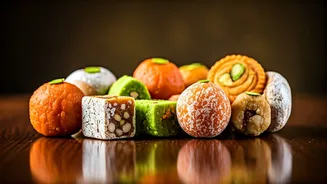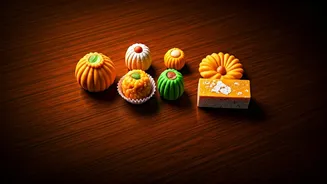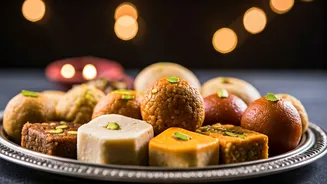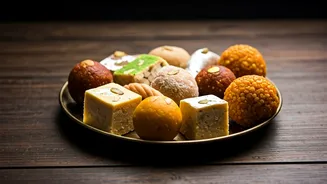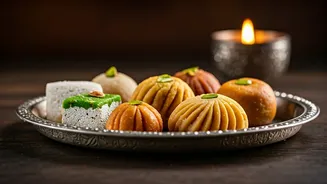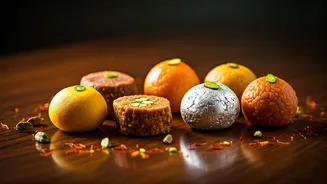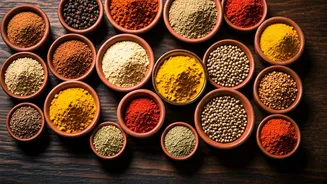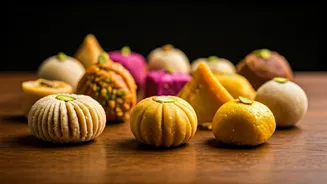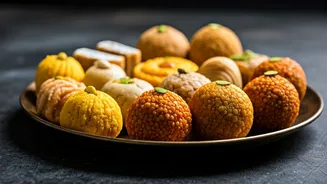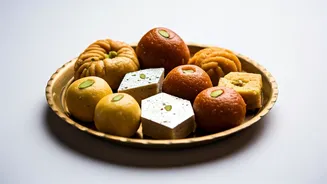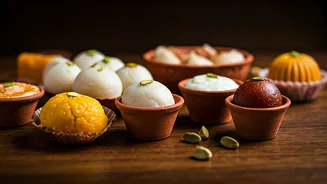Beyond Gulab Jamun
Diwali, the festival of lights, is undeniably linked with the indulgence of sweets. However, the traditional treats like gulab jamun, barfi, and jalebi,
while beloved, represent only a fraction of India's rich confectionery heritage. This Diwali, consider branching out from these staples. India's diverse regions boast a treasure trove of unique sweets, many of which remain relatively unknown. These less-celebrated desserts offer fresh flavors and textures, expanding the festive experience. Exploring these hidden gems adds a layer of novelty and surprise to the celebration. It's an opportunity to discover new favorites and appreciate the culinary diversity that defines India. This shift from the conventional encourages a more comprehensive appreciation for the country's varied culinary traditions.
Regional Specialties
Each region of India holds its own unique culinary treasures. In Bengal, the 'Mishti Doi' (sweet yogurt) and the delicate 'Rosogolla' are popular choices. Moving south, Karnataka presents 'Mysore Pak', a melt-in-your-mouth sweet crafted from gram flour, sugar, and ghee. Gujarat offers 'Ghugra', a sweet dumpling with a variety of fillings. Maharashtra has the famous 'Modak', traditionally offered during the Ganesh Chaturthi festival. Rajasthan showcases 'Ghevar', a disc-shaped dessert soaked in sugar syrup, and 'Malpua'. These regional variations showcase the diverse ingredients and techniques used across India. The use of locally sourced ingredients such as different types of flours, nuts, spices, and dairy products characterizes these regional sweets. These variations underscore India's rich culinary landscape, where each sweet narrates a unique story of culture, history, and tradition. Exploring these options elevates the Diwali experience by providing a wider array of flavors and textures, catering to diverse palates.
Rare Festive Sweets
Certain sweets, often reserved for specific festivals or special occasions, are less frequently encountered in the mainstream. 'Kajjikayalu' from Andhra Pradesh, a deep-fried pastry filled with coconut and jaggery, is a delightful treat. 'Pitha' from Assam is steamed or fried rice cakes. 'Shufta' from Kashmir, made with dried fruits and nuts, offers a rich and exotic experience. These sweets often reflect the local agricultural bounty. They also embody intricate culinary practices passed down through generations. Discovering these rare treats adds a sense of exclusivity and authenticity to the Diwali celebration. Many of these sweets are prepared with meticulous care, symbolizing the importance of the event. They also provide a glimpse into the diverse cultural practices and culinary traditions that thrive across the country. Such unique sweets provide a meaningful and enriching experience for all. This exploration allows for an enhanced celebration of the festival.
Sweet Pairing Tips
When curating a Diwali sweets platter, consider how different flavors and textures complement each other. Balance the richness of ghee-based sweets with lighter options. Contrast the sweetness with something subtly spiced. Pairing the classic gulab jamun with a refreshing 'Rasmalai' offers a satisfying mix. Introduce a crunchy element, like 'Chivda', to provide textural contrast. Serving a variety of flavors ensures that every guest finds something they enjoy. Consider the presentation – arrange the sweets artfully to enhance the visual appeal. Ensure the serving sizes are appropriate to allow guests to sample a variety without feeling overwhelmed. Think about the drinks pairings too; a cup of masala chai or a refreshing juice can make a perfect combination. These carefully considered pairings enhance the overall Diwali experience. By carefully pairing different sweets, you can achieve a more balanced and satisfying celebration.
Sourcing and Recipes
Finding these rare sweets might require some effort. Explore local sweet shops, especially those specializing in regional delicacies. Online platforms and food blogs are excellent sources for discovering new options. Many recipes are readily available online. Experimenting with homemade sweets can also be a rewarding experience. Look for recipes that use fresh, seasonal ingredients. Follow the instructions carefully for best results, and don't be afraid to add your own personal touch. Invite family members to participate in the preparation, making it a collective effort. Prepare sweets in advance to avoid last-minute rush. Even if you are not a seasoned cook, there is always time to learn. These efforts will enhance the enjoyment of Diwali. The preparation process can become an integral part of the festive experience. These resources will enable you to curate a unique and memorable Diwali celebration.
